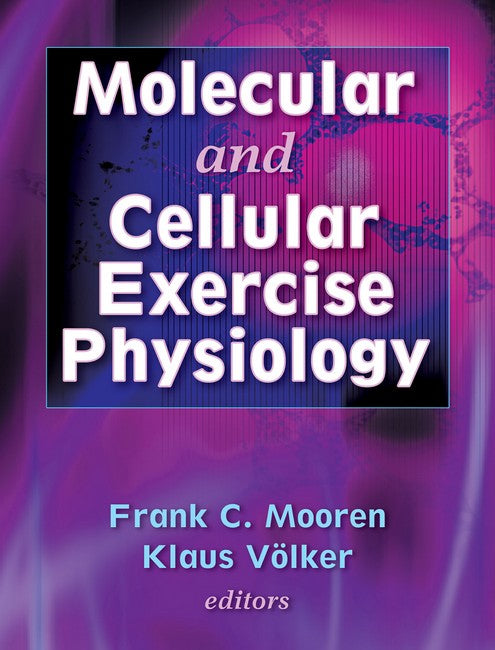Frank C. Mooren, MD, is associate professor at the Institute of Sports Medicine at University Hospital Muenster in Germany, where he leads a molecular exercise physiology research group. Drawing from an academic background in medicine and chemistry, he worked as a researcher at the Max Planck Institute for Sytemphysiology in Dortmund. He has also been a consultant in internal medicine and sports medicine at the University Hospital Muenster. Dr. Mooren is a member of the American College of Sports Medicine and the International Society of Exercise Immunology. He received the Heinz Zumkley Prize from the German Society on Minerals and Trace Elements in 1997 and the Arno Arnold Prize from the German Society of Sports Medicine and Prevention in 2001. Klaus VA?A?A"lker, MD, is director of the Institute of Sports Medicine at University Hospital Muenster in Germany, where he established a group for molecular research. He has devoted his career to the study of both sports science and medicine. He is vice president of the German Society of Sports Medicine and Prevention and chairman of its Commission of Sports for Youth, Leisure Time and Seniors. He is vice chairman of the Commission of Health of the Landessportbund NRW. He is a member of the American College of Sports Medicine, European College of Sports Medicine, and European Hypertension League.
Request Academic Copy
Please copy the ISBN for submitting review copy form
Description
Part I: Molecular Exercise Physiology Chapter 1. The Cell -Cellular Architecture -Exercise and the Cell -Conclusion Chapter 2. Cellular Life Span -Cell Cycle and Tissue Turnover -Cell Death -Effect of Exercise on Cell Proliferation and Cell Death -Conclusion Chapter 3. Genes, Genetic Heterogeneity, and Exercise Phenotypes -Genes and Genome -Gene Expression -Regulation of Gene Expression -Exercise and Gene Expression -DNA Sequence Variation -Genetics and Responsiveness to Exercise Training -Conclusion Chapter 4. Proteins and Exercise -Protein Synthesis -Protein Degradation -Exercise and Protein Metabolism -Conclusion Chapter 5. Extracellular Matrix and Exercise -Extracellular Matrices -Composition of the Interstitial Extracellular Matrix -Composition of Basement Membranes -Synthesis of Collagens -Degradation of Collagens -ECM of Skeletal Muscle -Muscle ECM and Physical Activity Chapter 6. Regulation of Intracellular Ion Composition and pH -Potassium -Intracellular pH Regulation -Magnesium Chapter 7. Inter- and Intracellular Signaling -Hormones and Receptors -Intracellular Signal Transduction Chapter 8. Energy Turnover and Substrate Utilization -Skeletal Muscle Carbohydrate Metabolism During Exercise -Recent Advances in the Regulation of Long Chain Fatty Acid Transport and Metabolism -Molecular Basis of Lactate Transport in Skeletal Muscle Chapter 9. Generation and Disposal of Reactive Oxygen and Nitrogen Species -Reactive Oxygen and Nitrogen Species in Living Organisms -Reactive Oxygen and Nitrogen Species in Exercise -Conclusion Chapter 10. Cellular Responses to Environmental Stress -Hyperthermia -Hypoxia Part II: Exercise and the Cell Chapter 11. Exercise and the Cardiac Myocyte -Structure of the Cardiac Myocyte -Contractile Cycle and Excitation-Contraction Coupling -Adaptive Hypertrophy and Growth Signaling -Contractile Function and Calcium Handling Chapter 12. Exercise and Endothelium -Endothelium Cell Function -Effects of Physical Training on Vascular Reactivity -Conclusion Chapter 13. Activity-Dependent Adaptive Responses of Skeletal Muscle Fibers -The Multiplicity of Sarcomeric Protein Isoforms -Myofibrillar Protein Isoforms and Fiber Diversity -Metabolic Adaptations of Muscle Fibers to Altered Functional Demands -Fiber Type Transitions -Signaling Pathways Related to Fiber Type Transitions -Conclusion Chapter 14. Exercise and the Alveolar and Bronchial Epithelial Cell -Airways -The Alveolar Epithelium Chapter 15. Exercise and the Liver Cell -Hepatic Carbohydrate Metabolism -Hepatic Lipid Metabolism -Conclusion Chapter 16. Exercise and the Adipocyte -The Adipocyte: Characteristics and Functions -Adipocyte Receptors and Exercise -Conclusion Chapter 17. Erythrocytes -Red Cell Production -Principles of O2 Transport by the Hemoglobin Molecule -Principles of CO2 Transport in the Blood -Regulation of Red Cell Volume -Red Cell Influence on Circulation and Respiration -Erythrocyte and Radicals -Conclusion Chapter 18. Leukocytes -Acute Exercise and Leukocytes -Mechanisms of Action -Chronic Exercise and Leukocyte Subpopulations -Exercise and Infections -Conclusion Chapter 19. Exercise and the Brain -Exercise Improves Cognitive Function in Humans and Prevents Age-Related Brain Atrophy -Animal Models to Study the Effects of Exercise on Brain Function -Exercise Up-Regulates Brain-Derived Neurotrophic Factor -Gene Microarray Analysis Reveals Other Genes That Are Regulated by Exercise -Exercise Enhancement of Learning and BDNF -Exercise and Depression -Definitive Role for BDNF in Human Cognition -CNS and Peripheral Regulatory Mechanisms of Exercise Effect on BDNF -Conclusion

